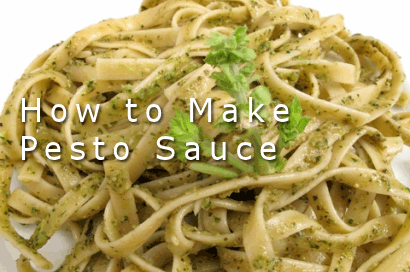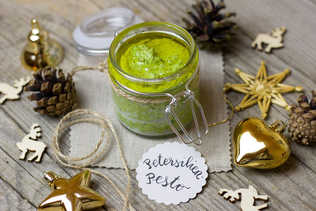How to make pesto sauce with a traditional recipe.

Pesto is an original, fresh herby sauce that is traditionally served with pasta.
In one form or another, pesto has been around since Roman times, although the pesto that we now know originates from Liguria, Italy, in the Genoa area, to be more precise, as its Italian name "pesto alla genovese" tells us.
The main ingredient of pesto sauce is basil, the fresher and more flavoursome the better. The best basil in Italy is grown in Liguria, which is probably why the sauce originated in this region.
Fresh basil can be bought from your local supermarket in the fresh herbs section, although if you are able to grow your own basil in your garden or even in a window box, your homemade pesto sauce is bound to be much more tasty and fresh.
In one form or another, pesto has been around since Roman times, although the pesto that we now know originates from Liguria, Italy, in the Genoa area, to be more precise, as its Italian name "pesto alla genovese" tells us.
The main ingredient of pesto sauce is basil, the fresher and more flavoursome the better. The best basil in Italy is grown in Liguria, which is probably why the sauce originated in this region.
Fresh basil can be bought from your local supermarket in the fresh herbs section, although if you are able to grow your own basil in your garden or even in a window box, your homemade pesto sauce is bound to be much more tasty and fresh.
Advertisements
The remaining ingredients that make up a pesto sauce are garlic, pine nuts, cheese, olive oil and salt and pepper.
There are variations on the above ingredients for example, walnuts are sometimes substituted for the pine nuts, the pine nuts may be toasted or roasted, a splash of lemon juice can be added and the type of cheese used depends on preferential taste.
The majority of recipes will call for freshly grated Parmesan, which is much better than the pre-packed grated Parmesan that you can buy from the supermarket.
For a stronger taste Pecorino (sheep's) cheese is used or a mixture of the two gives a full rich flavour.
As well as serving the pesto sauce with pasta, as is traditional, it can also be added to soups such as Minestrone or fish soup, in the final stages of cooking. Likewise, it can be used to spread onto bread or toast and can accompany cooked meat, poultry or even fish.
The preparation of pesto sauce does not involve cooking, which for some people may be a blessing in disguise. It was originally prepared by using a pestle and mortar, grinding all of the ingredients together to form a smooth paste.
Nowadays, most people use a food processor or blender to prepare their pesto sauce, which is handy if you are in a rush and do not have much time to prepare a meal. However, there are others who prefer to stick to the traditional method, as they say that the pesto sauce tastes much better.
Basically, the garlic, fresh basil, cheese and pine nuts are chopped and mixed together in the blender. Then, with the machine running, the olive oil is slowly poured into the processor and all of the ingredients are blended together. The sauce is then seasoned with the salt and pepper and is then ready to serve.
The pesto sauce may be kept for a week or slightly more in the refrigerator if you are not using it immediately. Store the sauce in an airtight container or jar with a thin layer of olive oil on top, which will prevent it from discolouring.
Below are several recipes for a classic pesto sauce.
There are variations on the above ingredients for example, walnuts are sometimes substituted for the pine nuts, the pine nuts may be toasted or roasted, a splash of lemon juice can be added and the type of cheese used depends on preferential taste.
The majority of recipes will call for freshly grated Parmesan, which is much better than the pre-packed grated Parmesan that you can buy from the supermarket.
For a stronger taste Pecorino (sheep's) cheese is used or a mixture of the two gives a full rich flavour.
As well as serving the pesto sauce with pasta, as is traditional, it can also be added to soups such as Minestrone or fish soup, in the final stages of cooking. Likewise, it can be used to spread onto bread or toast and can accompany cooked meat, poultry or even fish.
The preparation of pesto sauce does not involve cooking, which for some people may be a blessing in disguise. It was originally prepared by using a pestle and mortar, grinding all of the ingredients together to form a smooth paste.
Nowadays, most people use a food processor or blender to prepare their pesto sauce, which is handy if you are in a rush and do not have much time to prepare a meal. However, there are others who prefer to stick to the traditional method, as they say that the pesto sauce tastes much better.
Basically, the garlic, fresh basil, cheese and pine nuts are chopped and mixed together in the blender. Then, with the machine running, the olive oil is slowly poured into the processor and all of the ingredients are blended together. The sauce is then seasoned with the salt and pepper and is then ready to serve.
The pesto sauce may be kept for a week or slightly more in the refrigerator if you are not using it immediately. Store the sauce in an airtight container or jar with a thin layer of olive oil on top, which will prevent it from discolouring.
Below are several recipes for a classic pesto sauce.
Traditional pesto sauce
 Traditional pesto sauce
Traditional pesto sauce
Recipe description
This is a terrific sauce to make to go with pasta, especially if you are pushed for time. All of the ingredients can be popped in the blender and whisked together to make the sauce. This pesto sauce can be stored in the refrigerator for up to a week. This sauce contains fresh basil, garlic, olive oil, Parmesan and Pecorino cheese and pine nuts - a truly Mediterranean combination. Serves: 4 persons
Prep time: 5 mins
Cooking time: 0 mins
Total time: 5 mins
Ingredients
- 1 cup of fresh basil
- ¼ cup of freshly grated Pecorino cheese
- 1/3 cup of freshly grated Parmesan
- 2/3 cup of extra-virgin olive oil
- ½ cup of pine nuts
- 2 crushed cloves of garlic
- salt
Method
- Chop the basil, garlic, pine nuts and salt in a food processor until a purée has formed.
- Slowly add the olive oil, whilst the processor is still running and continue to blend for a few seconds.
- Switch the machine off and stir in the grated cheese.
- The sauce is now ready to serve, store in the refrigerator in an airtight jar or freeze.
Try this Italian recipe for spaghetti with fresh pesto sauce. It contains fresh basil and parsley, Parmesan cheese, olive oil, pine nuts and crushed garlic.
This is a variation of the classic pesto sauce. It contains all of the typical ingredients of an Italian pesto yet this recipe calls for the addition of butter or margarine also.
Advertisements
